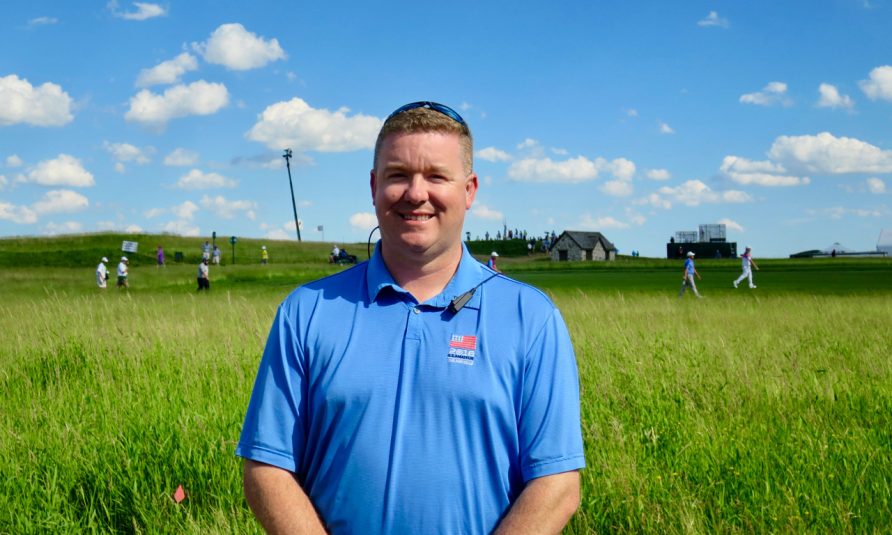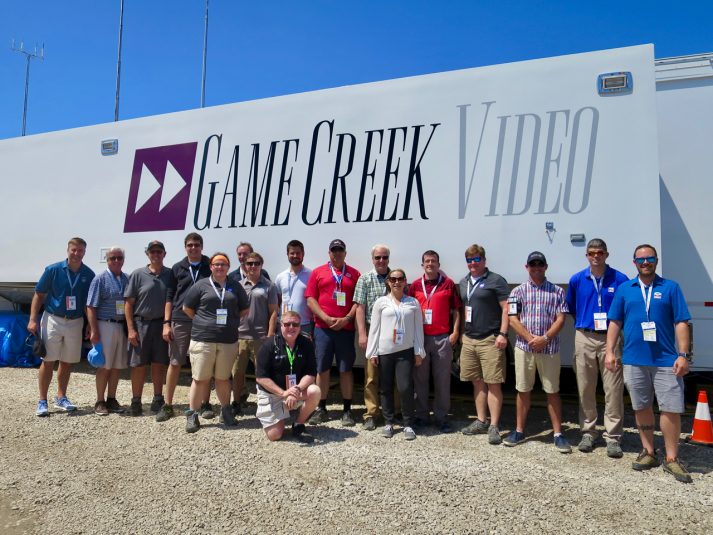Live From the U.S. Open: Fox Sports Offers a Full Course of Innovation
1080p RF cameras, revamped audio plan deliver for fans
Story Highlights
Day 2 of the 2017 U.S. Open at Erin Hills in Wisconsin is under way and, with it, another long day for the Fox Sports team, following a Day 1 that saw 15 hours of TV coverage, plenty of innovation, and even a bit of unexpected morning drama when an unauthorized blimp flying near the course crashed. It was also the culmination of months of work getting a golf course that had never hosted an Open ready for the big stage.

Fox Sports’ Brad Cheney: “We know the building blocks we need to do an Open, but every year has something new.
“Everybody stepped up, and we went into Wednesday more prepared than we have ever been, even after we modified a lot of the technology from last year, plus upped the number of cameras, shows, and hours of programming,” says Brad Cheney, VP, field operations and engineering, Fox Sports. “Today, we had 15-plus hours of continuous programming, beginning with Fox Business Channel for three hours at 5 a.m.”
It was only two years ago that Fox Sports broadcast its first-ever U.S. Open golf coverage, from Chambers Bay outside Seattle. The network did what most do the first time it broadcasts a top event: aggressively step up the size, scale, and scope of the production to ensure maximum flexibility, buzz, and control. In the following years, the show then tends to scale down and cast aside some of the bells and whistles. That did, in fact, happen last year at the U.S. Open at Oakmont.
But this year’s show is bigger than the one at Chambers Bay, with shot-tracing technology on every hole, three holes of 4K coverage, and an increased presence by other Fox networks. All the shows done for Fox Business Channel, FS1, and other Fox properties are handled by the core Fox Sports production team.
“They aren’t standalone; they are part of our main production setup,” Cheney explains. “We’re extremely happy with how all of those extra shows have gone. And It’s just proof of what everyone can get done, from producer Mark Loomis and director Steve Beim to the technicians and our vendors.”
According to Mike Davies, SVP, field and technical operations, Fox Sports, the production team’s accomplishment at the U.S. Open is impressive, given that Fox Sports is also gearing up in Russia for the Confederations Cup, a tournament played in the World Cup host country and very much a test bed for what will happen the following year.
“The summer ends up being a seriously busy time of year for us: we have two major projects going on simultaneously,” he points out. “And you see our departments firing on all cylinders after a reorganization in the winter that sees all the operations like studio, field operations, and postproduction under one umbrella. That move made all the sense in the world, and I’m proud of the team.”
Once again, Game Creek Video is onsite in force, with the Encore production unit at the center of the on-course coverage. The only modification in the lineup is that Maverick has replaced Glory for 4K coverage of Holes 13, 14, and 15. Because Maverick was used by DirecTV at The Masters, rolling it in for the U.S. Open made the 4K integration easier with the truck all set from an engineering standpoint. The HD coverage on those holes relies on Sony HDC-4300 cameras outputting two signals, a 4K and a 720p, via the camera control unit (CCU).
Another change from last year is that seven RF cameras are operating in 1080p mode.
“When we started using 1080p RF handheld cameras last year, we saw a big gain in quality,” says Cheney. “And the look from the 1080p RF cameras is very close to matching the quality of the 720p hard-wired cameras.”
Another new RF advance this year is that the Sony F55 camera — used for capturing cinematic footage for bumpers, opens, and features — uses RF transmission to send live images to the compound. Previously, images captured on that camera would require that the footage on its storage cards be dumped into an editing system.
“We thought, what if we could take that same cinematic look on the bumps and teases and get it on-air more quickly,” says Davies. “We are looking at how to incorporate feature material. Once we get good at it, we will be able to turn it around even faster.”
Also onsite supporting Fox Sports are CP Communications, BSI, CAT, Bexel, VER, Encompass Digital Media, CMSI, and Inertia Unlimited.
The core of the production will rely on 110 cameras and 216 microphones, including 26 wireless cameras, 31 wired cameras (12 with 100X Canon lenses, 19 with 95X Canon lenses), three Inertia Unlimited X-Mo cameras, and a Sony HDC-4800 operating at 960 fps. Three RF Tracer cameras will also be in use. The Towercam, which allows a camera to be raised 18 ft. into the air, is also back but in a bigger way: it is now on a Gator tractor from John Deere. A 75-ft. Strada crane and four jib cameras are also onsite.
Audio enhancements include hole microphones in all 18 cups as well as a modified audio-effects microphone plan to offer more-consistent coverage via 216 microphones. And, this year, CP Communications is handling all the RF audio needs on the course, a change from previous Opens.
“We know the building blocks we need to do an Open.” says Cheney, “but every year has something new. We also have had two courses that are hosting their first Open, and that is a challenge for everybody; our partnership with the USGA has made each of these a success. The course looks phenomenal on TV.”

